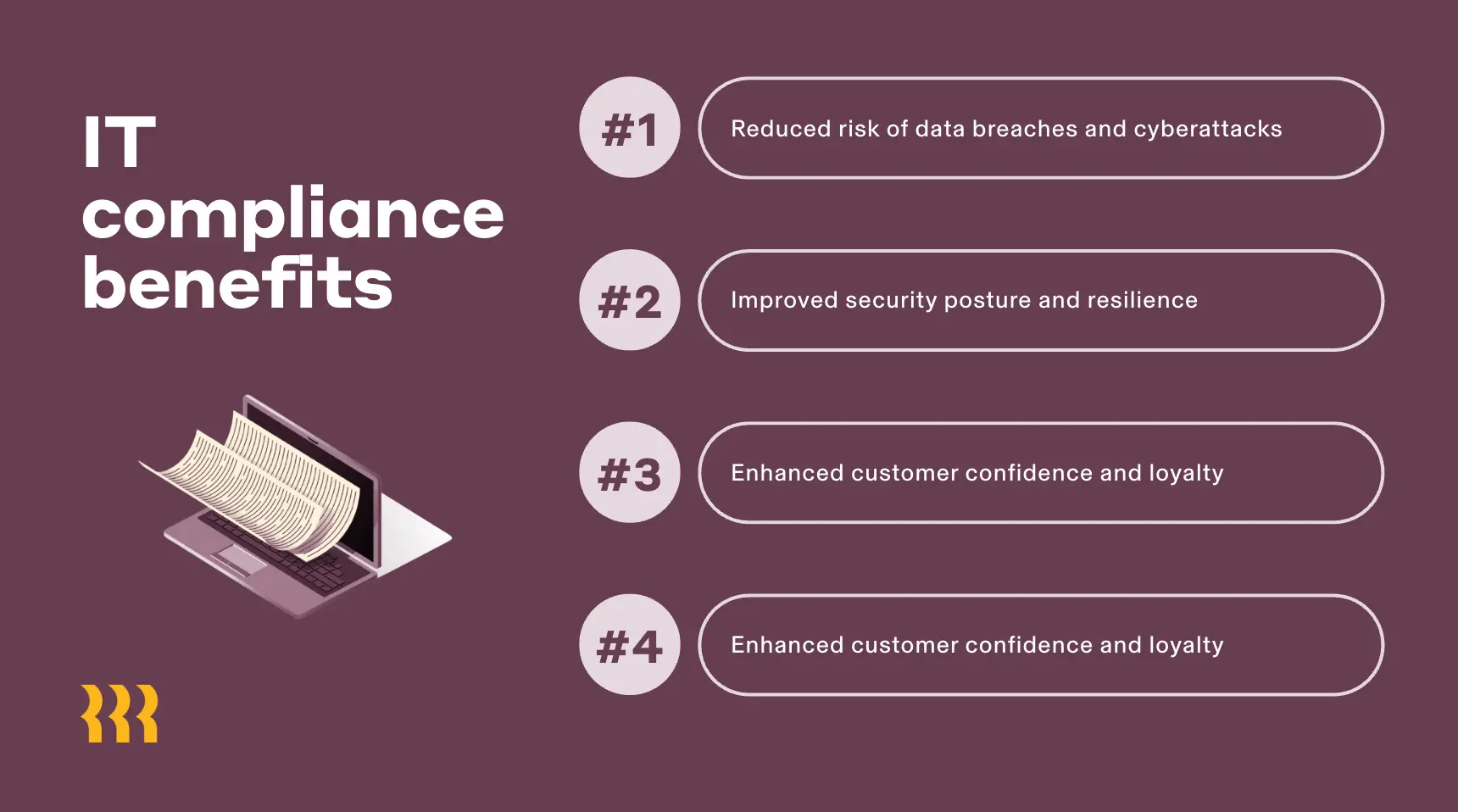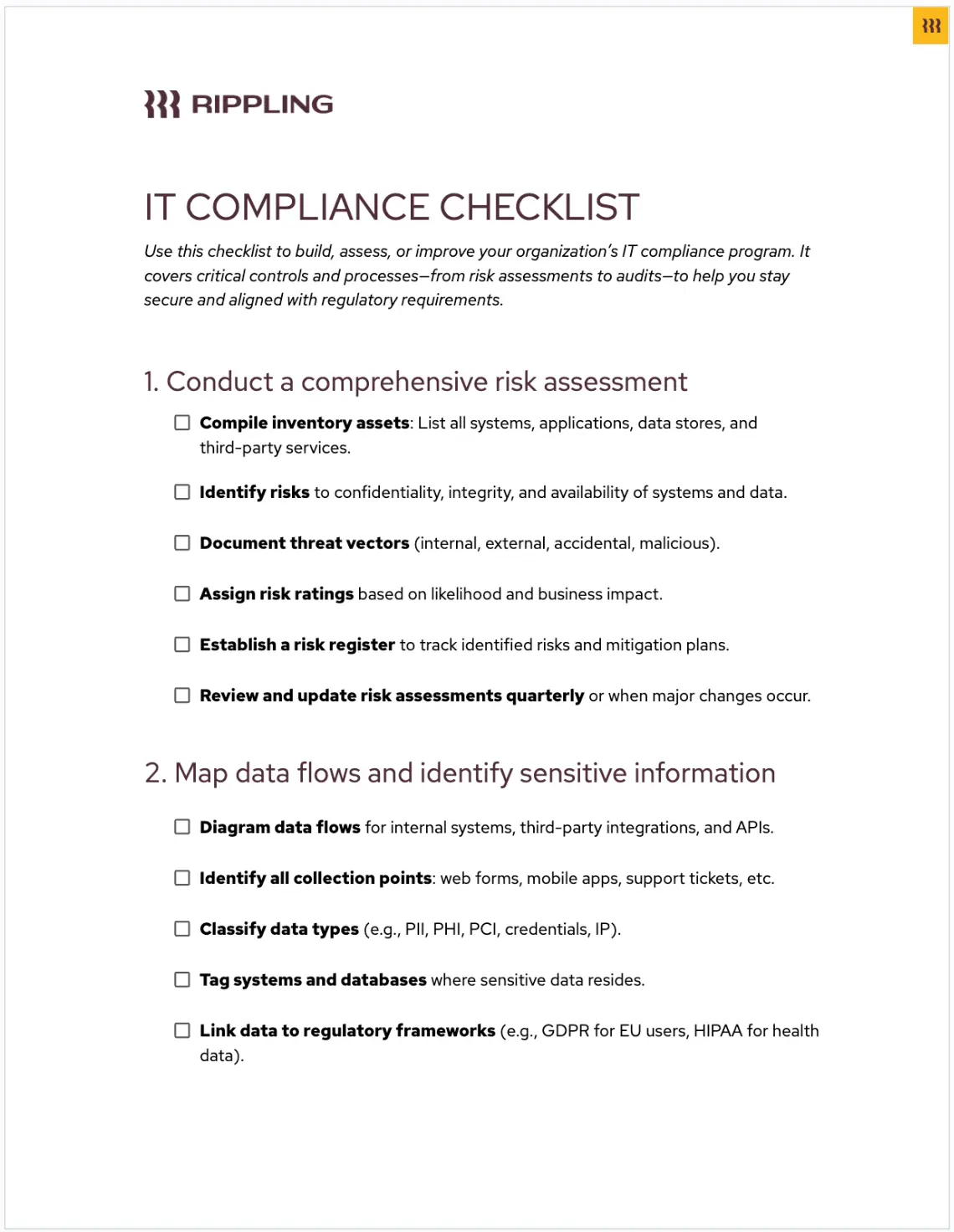What is IT compliance? Risks, best practices, & checklist (2025)

In this article
- 011. IT compliance FAQs
Your startup just landed its first enterprise customer, and they're asking for your SOC 2 report. Or maybe you're processing payments and just realized you need to be PCI compliant. Suddenly, compliance isn't some abstract concept. It's the thing standing between you and closing that deal.
IT compliance might sound like boring paperwork, but in reality, it's about building systems that protect your business and win customer trust. Yes, it helps you avoid costly fines—but more importantly, it lays the foundation for a company that’s resilient, trustworthy, and aligned with the expectations of security-conscious clients.
This matters more than ever when 95% of cybersecurity breaches are caused by human error, making structured compliance frameworks essential for guiding employee behavior and reducing risks.
This guide breaks down what IT compliance actually means, when you need it, and how to build systems that satisfy auditors without paralyzing your team.
What is IT compliance?
IT compliance means following formal rules about how your company handles data and operates its technology systems. These rules come from a mix of sources:
Government regulations (like GDPR, HIPAA)
Industry standards (like PCI DSS)
Internal company policies aimed at reducing risk
What makes IT compliance different from general security practices is that it requires you to follow clearly defined rules and maintain documentation that proves you're doing so. Depending on the framework, that might mean passing a formal audit, completing assessments, or being able to show evidence during an investigation or customer review.
IT compliance vs. IT security
IT security and IT compliance often overlap but address different needs. Knowing the difference helps you focus your resources effectively instead of treating them as the same thing.
Aspect | IT security | IT compliance |
|---|---|---|
Primary goal | Protect data, systems, and infrastructure from threats | Demonstrate adherence to legal and industry standards |
Driven by | Internal risk assessment and threat landscape | External regulations and audit requirements |
Focus | Proactive threat prevention and incident response | Documentation, controls, and audit readiness |
Approach | Flexible, adaptive to emerging threats | Structured, follows specific frameworks |
Examples | Firewalls, endpoint protection, intrusion detection | HIPAA, PCI DSS, SOC 2, ISO 27001 frameworks |
While security teams focus on defending against hackers and the latest threats, compliance teams focus on demonstrating to auditors that you meet required standards.
Both are essential. Strong security without compliance documentation risks penalties, while compliance without real security is just costly paperwork that won’t stop attackers.
Why is IT compliance important?
The most obvious reason to pursue IT compliance is to avoid costly penalties. Regulatory violations can lead to fines ranging from hundreds of thousands to millions of dollars. In fact, the average cost of a data breach reached $4.88 million in 2024, with regulatory fines adding significant additional expenses on top of remediation costs.
More importantly, compliance requirements are built around security practices that actually work. Following frameworks like SOC 2 or ISO 27001 forces you to implement security procedures that protect against common attack methods.
Then there's the trust factor. In competitive markets, showing compliance through certifications and audit reports gives prospects confidence that you'll handle their data responsibly. Many enterprise customers won't even talk to vendors without current compliance certifications.
Benefits of IT compliance
Here are some more benefits of IT compliance that go beyond just avoiding penalties.

Reduced risk of data breaches and cyberattacks
Compliance frameworks require security controls that directly reduce your attack surface. When you implement needed measures like access controls, encryption, network segmentation, and monitoring, you're creating multiple layers of defense that make successful attacks much harder to pull off.
Improved security posture and resilience
Following compliance standards forces you to document security processes, conduct regular risk assessments, and maintain incident response plans. This systematic approach makes your organization more resilient and better prepared to handle both planned changes and unexpected problems.
Enhanced customer confidence and loyalty
Compliance certifications work as third-party validation of your security practices. When prospects see SOC 2 reports or ISO certifications, they know you've invested in protecting their data and had independent auditors verify your controls actually work.
Easier audit processes and certifications
Once you establish compliance processes, maintaining them becomes much more manageable. Annual audits become routine instead of disruptive, and adding new compliance requirements builds on your existing foundation rather than starting over.
When is it necessary to ensure IT compliance?
During system implementations or upgrades
Major technology changes give you the perfect opportunity to build compliance into your systems from the ground up. It's much easier to configure new systems with proper access controls, logging, and security settings than to retrofit compliance into existing environments.
When handling sensitive or regulated data
The moment you begin collecting credit card information, health records, or personal data, specific compliance requirements apply. Knowing these requirements upfront helps you avoid costly fixes after the fact.
Before audits or regulatory inspections
Whether you're pursuing a compliance certification or facing a regulatory investigation, having your compliance posture documented and verified is essential. Waiting until audit time to address compliance gaps often leads to delays, additional costs, or audit failures.
When expanding into new markets or regions
Different countries and regions have varying data protection and privacy requirements. Expanding into Europe triggers GDPR requirements, while entering certain industries may require industry-specific certifications or compliance frameworks.
During vendor evaluations and contract negotiations
Many enterprise customers now require compliance certifications from their vendors. Having current audit reports and certifications ready can accelerate sales cycles and demonstrate your commitment to security and data protection.
Types of IT compliance regulations
Data privacy (GDPR, CCPA)
Data privacy regulations focus on how organizations collect, process, store, and share personal information. The EU General Data Protection Regulation (GDPR) applies to any organization handling EU residents' data or that is established in the EU, while the California Consumer Privacy Act (CCPA) covers businesses serving California residents. These regulations may require consent for data collection, provide certain privacy rights such as data deletion, and also include breach notification requirements.
Financial regulations (SOX)
The Sarbanes-Oxley Act (SOX) requires US public companies to maintain accurate financial records and implement controls over financial reporting. IT systems that support financial processes must have proper access controls, change management procedures, and audit trails to ensure data integrity and prevent financial fraud.
Healthcare (HIPAA)
The Health Insurance Portability and Accountability Act (HIPAA) governs how US healthcare organizations and their business associates handle protected health information (PHI). Requirements include specific security measures such as access controls, encryption, audit logging, and employee training to ensure patient privacy and data security.
Payment card security (PCI DSS)
The Payment Card Industry Data Security Standard (PCI DSS) applies to certain organizations that process, store, or transmit credit card information. Requirements include network security, access controls, encryption, and regular security testing to protect cardholder data from theft and fraud.
Cybersecurity frameworks (ISO 27001, NIST)
ISO 27001 provides a comprehensive foundation for information security management systems, while NIST compliance frameworks offer guidance for security practices. These standards help organizations establish systematic approaches to cybersecurity compliance and IT risk management.
Government and defense (FISMA, NIST SP)
Federal agencies and their contractors must comply with the Federal Information Security Management Act (FISMA) and related NIST standards. These frameworks establish minimum security requirements for government systems and controlled unclassified information.
Environmental and sustainability regulations
Emerging regulations around electronic waste, energy efficiency, and carbon reporting are creating new compliance requirements for IT organizations. These may include requirements for responsible device disposal, energy usage reporting, and sustainable procurement practices.
Ultimate IT compliance checklist
To effectively manage IT compliance, follow this step-by-step checklist that covers key areas from risk assessment to ongoing monitoring and incident response:
1. Conduct a comprehensive risk assessment
Start by identifying all the ways your organization could face security, privacy, or regulatory risks. Document your data flows, system dependencies, and potential threat sources. Assign likelihood and impact ratings to each risk, and update your assessment regularly as your business and threat landscape evolve.
2. Map data flows and identify sensitive information
Create detailed documentation of how data moves through your organization, from collection points through processing, storage, and eventual deletion. Identify what types of sensitive data you handle (personal information, payment data, health records) and which compliance requirements apply to each type.
3. Develop or update policies aligned with regulations
Create written policies that address each applicable compliance requirement. These should cover data handling procedures, incident response, employee training, and vendor management. Make sure policies reflect your actual business processes rather than generic templates.
4. Implement access controls and encryption
Deploy technical controls to restrict access to sensitive systems and data. This includes multi-factor authentication, role-based access controls, encryption for data at rest and in transit, and regular access reviews to ensure people only have the permissions they need.
5. Train employees on security protocols
Develop training programs that help employees understand their compliance responsibilities and how to follow security procedures in their daily work. Include role-specific training for employees with elevated access or security responsibilities, and track completion to ensure everyone stays current.
6. Regularly audit systems and processes
Establish schedules for testing your controls and reviewing your compliance posture. This includes IT audits, vulnerability assessments, access reviews, and policy reviews. Document all testing activities and remediate any identified gaps promptly.
7. Document all activities for accountability
Maintain detailed records of your compliance activities, including policy approvals, training completion, audit results, and remediation efforts. This documentation proves to auditors that you're actively managing compliance and helps you track improvements over time.
8. Ensure third-party and vendor adherence
Evaluate the compliance posture of vendors who have access to your systems or data. Include appropriate security and compliance requirements in vendor contracts, and conduct regular assessments to ensure they maintain adequate controls.
9. Prepare incident response plans
Develop documented procedures for responding to security incidents, data breaches, and compliance violations. Include notification requirements, escalation procedures, and communication templates to ensure you can respond quickly and appropriately when incidents occur.
10. Stay updated on new IT compliance regulations
Assign responsibility for monitoring changes in applicable regulations and industry standards. Subscribe to relevant regulatory updates, participate in industry groups, and work with legal counsel to understand how changes might affect your compliance requirements.
Need a step-by-step guide to implementing IT compliance in your organization? Download our free IT compliance checklist.

Common IT compliance mistakes to avoid
Even well-meaning organizations slip up when it comes to compliance. Here are some of the most common IT compliance mistakes, and how to avoid them.
1. Neglecting regular updates
Compliance isn't a one-time project. It requires ongoing attention as regulations evolve and your business changes. Organizations that treat compliance as a checkbox exercise often find themselves facing non-compliance issues when audit time arrives or when new requirements take effect.
2. Inadequate employee training
Your compliance controls are only as strong as the people who implement them daily. Failing to provide comprehensive, role-specific training leads to policy violations, security gaps, and audit findings that could have been easily prevented.
3. Poor documentation
Auditors need to see evidence that your controls are working as designed. Organizations with incomplete, outdated, or disorganized documentation struggle during audits and may receive qualified opinions even when their actual security practices are sound.
4. Overlooking third-party risks
Vendors and business partners can create compliance gaps if they don't maintain appropriate security controls. Many compliance violations result from third-party failures rather than direct organizational lapses. Research indicates that 61% of companies experienced third-party data breaches in 2024, highlighting the critical importance of vendor risk management.
5. Ignoring data mapping and classification
You can't protect what you don't know about. Organizations that haven't thoroughly mapped their data flows and classified their information assets often discover compliance gaps during audits or after incidents occur.
6. Underestimating the scope
Compliance requirements often extend beyond obvious systems to include backup systems, development environments, and business processes that touch regulated data. Failing to include all relevant systems in your compliance scope creates dangerous blind spots.
7. Relying solely on manual processes
Manual compliance processes are error-prone, time-consuming, and difficult to scale. Organizations that don't leverage automation for routine compliance tasks often struggle to maintain consistent compliance as they grow.
How can you reduce IT compliance risks?
You can't eliminate compliance risks entirely, but following these best practices can help you minimize them:
Regular training and awareness programs
Implement comprehensive security awareness training that goes beyond annual compliance videos. Include phishing simulations, role-specific training modules, and regular updates on emerging threats and policy changes. Track training completion and comprehension to ensure your program is effective.
Rippling’s learning management software provides compliance-required training alongside customized learning programs. Whether you want to pick from a catalog of pre-built courses or create your own, Rippling helps automate training reminders and tracking—so you don’t have to worry whether your team is meeting compliance requirements.
Continuous monitoring and auditing
Deploy automated monitoring tools that can detect policy violations, unauthorized access, and other compliance issues in real time. Conduct regular internal audits to identify gaps before external auditors find them, and maintain documentation of all monitoring and testing activities.
Vendor risk management
Establish formal processes for evaluating, monitoring, and managing third-party compliance risks. Include specific security and compliance requirements in vendor contracts, conduct regular vendor assessments, and maintain documentation of vendor compliance status.
What do IT security compliance services include?
IT compliance services help organizations meet regulatory requirements, protect sensitive data, and streamline compliance management more efficiently. They go beyond checklists to support real-world implementation and long-term accountability.
Key services typically include:
Risk assessments to identify compliance gaps and prioritize fixes
Policy development tailored to your specific regulations and workflows
Employee training, both general and role-based, to ensure everyone understands their responsibilities
Audit support to gather evidence and guide you through compliance reviews
Vendor management to assess and monitor third-party risks
Ongoing monitoring to track control effectiveness and catch issues early
Platforms like Rippling combine some of these services into one integrated solution, making it easier to build, manage, and scale compliance across your organization.
Streamline IT compliance with Rippling
Rippling IT management software transforms IT compliance from a manual, error-prone process into an automated system that works seamlessly with your existing business operations.
Role-based permission automation ensures that access controls update automatically when employees change roles, join, or leave your organization. Through Supergroups (dynamic membership lists built using employee attributes), permissions adjust automatically as people's roles evolve, eliminating manual processes that often create compliance gaps and providing auditors with comprehensive, real-time documentation of access controls.
Approval workflow automation streamlines compliance-related approvals by automatically routing requests to the right approvers based on employee attributes like tenure and department. The platform supports complex approval chains and can handle situations like re-routing requests when primary approvers are unavailable, ensuring compliance processes continue smoothly even as your organization evolves.
The unified platform approach means compliance data flows seamlessly between HR and IT systems, providing complete visibility into user access, device management, and policy enforcement without manual data reconciliation or complex integrations.
IT compliance FAQs
What is the difference between IT audit and IT compliance?
IT compliance involves following ongoing rules and standards to protect data and systems, while an IT audit is a specific examination to verify that you're actually following those rules. Think of compliance as the daily practice of following speed limits, while an audit is like a traffic stop where someone checks whether you've been driving safely.
How do you choose an IT compliance tool?
Look for platforms that unify HR and IT data rather than requiring separate point solutions for each compliance requirement. The best compliance tools automatically generate audit evidence from your existing business operations, provide real-time visibility into access controls and policy enforcement, and use employee attributes to dynamically apply the right policies to the right people. Consider platforms like Rippling that treat compliance as a natural byproduct of proper employee lifecycle management rather than a separate overlay requiring constant manual maintenance.
Are there different levels of certifications for meeting IT requirements?
Yes, many compliance frameworks offer different levels or types of certification. For example, SOC 2 has Type 1 (point in time) and Type 2 (period of time) reports, while cloud security frameworks often have multiple certification levels based on the rigor of controls implemented. Some frameworks also offer self-assessment options alongside formal third-party audits.
What is an example of IT compliance?
A common example is PCI DSS compliance for any business that processes credit card payments. This requires implementing specific security controls like encryption, access restrictions, network monitoring, and regular security testing. Companies must undergo annual assessments and maintain continuous compliance to keep processing payments legally and safely.
This blog is based on information available to Rippling as of September 15, 2025.
Disclaimer
Rippling and its affiliates do not provide tax, accounting, or legal advice. This material has been prepared for informational purposes only, and is not intended to provide or be relied on for tax, accounting, or legal advice. You should consult your own tax, accounting, and legal advisors before engaging in any related activities or transactions.
Hubs
Author
The Rippling Team
Global HR, IT, and Finance know-how directly from the Rippling team.
Explore more
See Rippling in action
Increase savings, automate busy work, and make better decisions by managing HR, IT, and Finance in one place.




















































































































